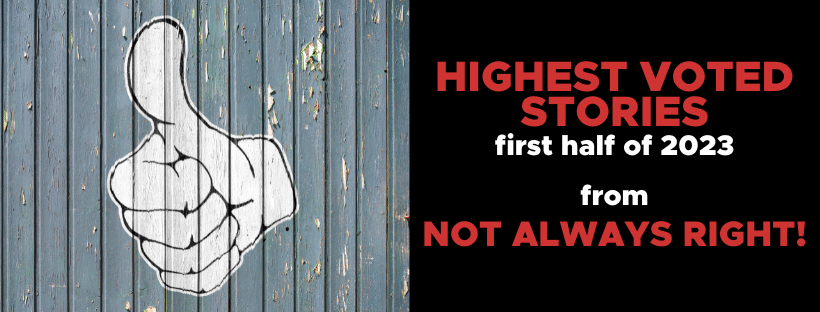I have been working at my grocery store for a few years so whenever we get anyone new on the floor I take them under my wing until they’re up to speed. Our latest hire is a super-sweet sixteen-year-old girl who is working at the weekends to save up enough to not be a burden on her parents who are struggling a bit. She’s super nice and super hard-working.
This is why it pained me to see her walking away from a customer with tears down her face.
Coworker: *Through sniffs and crying.* “Can you please assist the customer in the baking aisle, I… I wasn’t able to give her what she needed.”
She pushed on through to the back to no doubt calm down, and I proceed to the customer she had just interacted. And there she stood… imagine the typical Not Always Right customer and she fitted the description to a tee – the oversized sunglasses, the designer bag, the “I want to speak to the manager” hairstyle, it was almost comical.
Before I could even speak, she starts running her mouth.
Customer: “Hopefully you’ll be of more use to me than that child you have working here. Absolutely useless, I should complain to management about your hiring processes but lucky for you all I am pressed for time.”
She’s pressed for time, but she hasn’t actually asked me anything yet. I stand and smile patiently.
Customer: “I’m making a mirror-glaze cake for the school bake sale and I refuse to be outdone. I need gelatine for the glaze and your stupid little colleague asked me if I would be making the cake for vegetarians! As if I would be stupid enough to accidentally put any meat into my cake!”
I realize my coworker was trying to be helpful and was likely recommending gelatine products that were standard (i.e. made from collagen from animals) or vegetarian options. However, this customer has still not stopped rattling on.
Customer: “I have been making the best cakes at my school bake sales for years and no one can believe they are vegetarian and vegan, and I do not intend to lose this year! Now if you would like to not get management called, please fetch me five more of these.”
The customer holds up a package of the gelatine she is using for her mirror-glaze, a brand that is most definitely NOT vegetarian.
Me: “Certainly, ma’am. I wouldn’t want to tell you how to bake your own cakes, especially when it sounds like you have as much experience as you do.”
She sniffs in approval of my “subservience” and I fetch her items for her.
Just over a week later I am working in another corner of the store, and I hear a loud barrage of obscenities and the voice of my manager trying to calm someone down. I peek my head around the corner, and I see the same customer, snarling and almost foaming at the mouth. She is pointing at my sixteen-year-old coworker and the manager is standing in the way.
When I next see the coworker in the break room, I ask what that was all about.
Coworker: “Oh, that. That woman is the mother of someone I go to school with, the leader of the “mean-girl” pack. Her daughter gets away with bullying because as soon as there is a complaint, she rolls up in her fancy car and strong-arms the principal into doing her bidding.”
Me: “Okay?”
Coworker: “She’s run the school charity bake sale every year since I can remember, something to make her look good but she uses it for bragging rights. She always boasts that her cakes are vegan and such, so when she found me in the aisle last week asking about gelatine I thought I should confirm if she was making a vegan cake or not. That’s when she exploded on me and I… I got a bit upset.”
Me: “You did fine, don’t worry about that.”
Coworker: “Oh I’m not worried. I posted this on the school’s Facebook page on the bake sale event.”
She shows me her phone. She posted this next to a picture of her “vegan” cakes.
Coworker’s Post: “Hey, Mrs. [Customer’s Name] if your cakes are vegan why did you scream at me to the point of crying last week when I tried to stop you from buying [meat-based gelatine] to put into your cake?”
What followed was a string of comments stating shock and disgust, such as “I’m a vegan and you made me eat meat?!” and “I’m never eating your s*** ever again!” and so on. It got worse, but hey… internet comments.
Coworker: “So she came back and tried to get me fired. Not much they can do though – I read the rules – I am simply a student at a school sending a personal message on said-schools private chat group. It’s a school issue, not a [Grocery Store] issue. She couldn’t get me expelled so now she’s trying to get me fired.”
She was right. The store or management couldn’t do anything, and the customer couldn’t even get Corporate to do her bidding, something she wasn’t used to. My sweet young coworker who I thought was going to be a quiet little sensitive thing only needed to work in a grocery store for a few weeks to become something scary and capable of revenge. Ah, retail…
This story is part of our Highest-Voted-Stories-Of-2023-(so far!) roundup!
 Read the next Highest-Voted-Stories-Of-2023-(so far!) story!
Read the next Highest-Voted-Stories-Of-2023-(so far!) story!
Read the Highest-Voted-Stories-Of-2023-(so far!) roundup!



